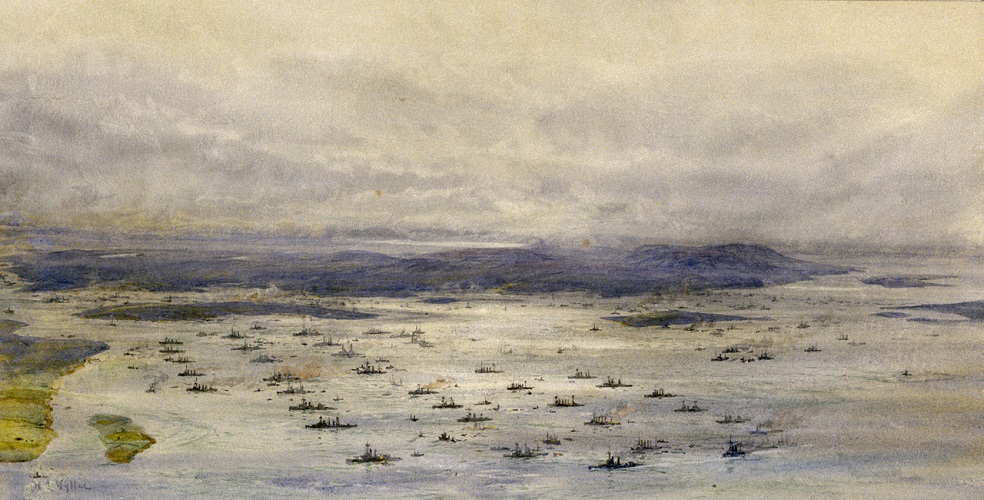● ● ●
Note on Comparative
Naval Ranks
Though flag officers’ rank
titles varied from navy to navy, their overall rank
structures were similar. The Royal Navy’s flag ranks were
Admiral of the Fleet, Admiral, Vice-Admiral, Rear-Admiral
and Commodore—the last entitled to fly the so-called broad
pennant instead of a rank flag. In the German Navy the ranks
were Grand Admiral (Großadmiral), Admiral (Admiral),
Vice-Admiral (Vizeadmiral) and Rear-Admiral (Konteradmiral).
Commodore (Kommodore) in the German Navy was not a
rank but an appointment—typically of a Captain (Kapitän
zur See) appointed to command a flotilla or group of
ships. While holding such an appointment he was authorized
to use the title Kommodore and to fly a broad
pennant.
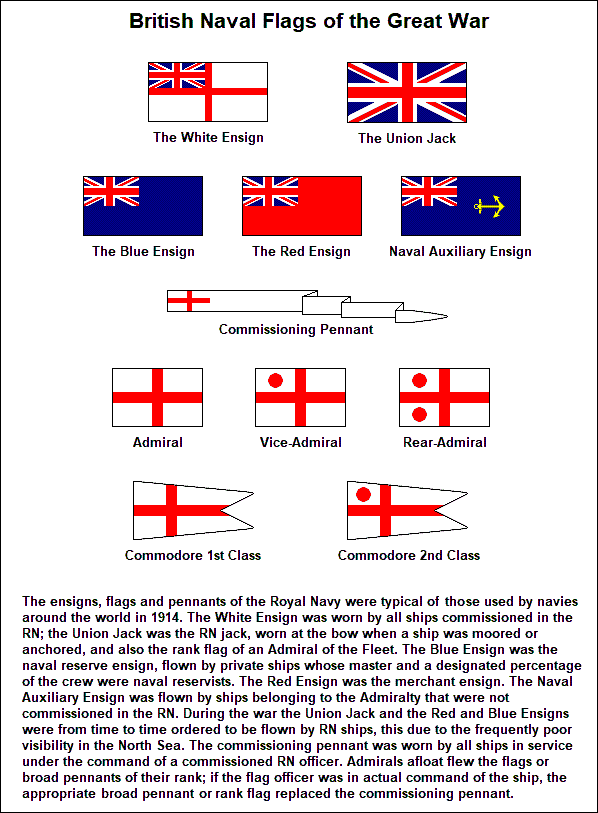
● ● ●
One of the most consequential
decisions of the Great War was taken by Winston Churchill,
First Lord of the Admiralty, on 2 August 1914.
Coincidentally with the Balkan crisis sparked by the
assassination of the Austro-Hungarian heir, Archduke Franz
Ferdinand, the Admiralty had been conducting a test
mobilization of the Royal Navy. This involved the recall of
naval reservists to man ships in caretaker status, followed
by the concentration of the fleet at its war stations in
home waters. Anticipating that Britain would likely be drawn
into the war just beginning, the First Sea Lord, Admiral
Prince Louis of Battenburg, ordered the Fleet’s scheduled
demobilization to be delayed. Churchill, reaching the
Admiralty from his country home some hours later, confirmed
Battenburg’s order. Thus when Britain did declare war on
Germany (4 August), the Fleet was ready.
As with land warfare, modernity and
the Industrial Revolution had revolutionized the naval scene
between 1815 and 1914. The Royal Navy of the Napoleonic era,
wooden-walled, sail-propelled, armed with short-range
smoothbore cannon, was but a memory. Now steam, iron and
steel, high explosives and long-range gunnery were dominant,
embodied above all in the dreadnought battleship, which may
well be said to have represented the pinnacle of military
technology in 1914.
This class of warships took its
name from the first of the breed: HMS Dreadnought,
which was entered service with the Royal Navy in 1906.
Dreadnought represented a revolutionary break with past practice.
By the late nineteenth century battleship design had settled
into a standard pattern. The typical battleship, circa 1900,
displaced about 15,000 tons, had a maximum speed of about 18
knots, was propelled by reciprocating steam engines, and was
armed with four guns of 12-inch caliber. These main battery
guns were supplemented by a secondary battery of some dozen
5- or 6-inch guns plus smaller quick-firing guns for defense
against torpedo boats. Many such battleships were
additionally armed with torpedo tubes. The maximum effective
range of the big guns was about 10,000 yards, though
anticipated battle ranges were much shorter: 5,000 yards at
most. The last British battleships of this type, the six
ships of the “Duncan” class, were commissioned in the Royal
Navy as late as 1903-04.
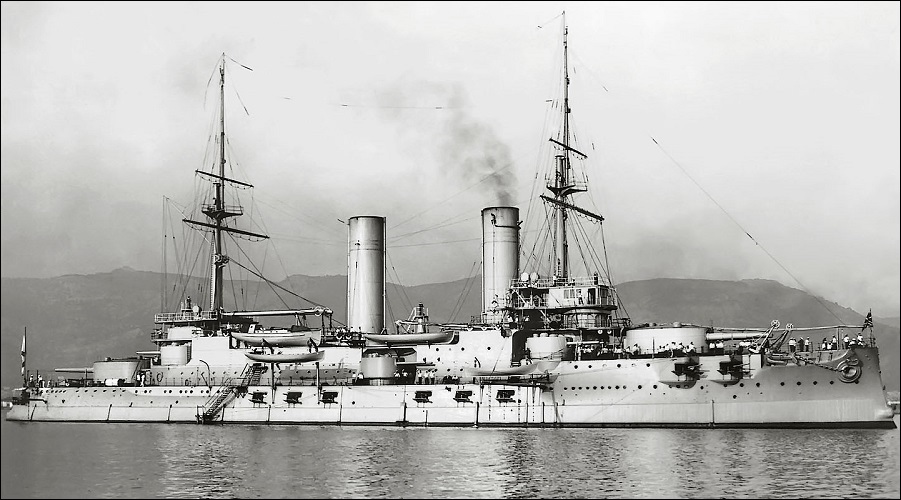
A typical battleship, circa 1900: the
Imperial Russian Navy's Slava. On a displacement of
13,500 tons she carried an armament of 4 x 12in guns and 12
x 6in guns in turrets, plus 20 x 3in guns in hull positions and a pair
of submerged torpedo tubes. Her best speed was 18 knots.
(Imperial War Museum)
But even as the “Duncans” entered
service, there was growing concern among senior British
naval officers that their battleships lacked sufficient
firepower. The latest foreign battleships were being armed
with an intermediate battery of 8in guns in addition to
their 12in and 5- or 6in batteries. An example was the Japanerse
“Kurama” class, armed with 4 x 12in and 8 x 8in guns. Britain's reply was
the “King Edward VII” class (eight units), laid down in 1902 and
commissioned in 1905-07. These handsome ships displaced some
1,000 tons more than the “Duncans” and were armed with four
12in, four 9.2in and ten 6in guns. The 9.2in gun was a
powerful weapon that nearly doubled the ships’ firepower—on
paper. But this mixed main armament turned out to embody a
serious flaw. Naval gunfire was adjusted by observing shell
splashes and correcting the firing data accordingly.
Unfortunately, it was found that 12in and 9.2in shell splashes were practically impossible to
distinguish from one another at expected battle ranges,
which made mixed-caliber salvo firing difficult if not
impossible.
For some years, however, a much
more revolutionary idea, the “all-big gun” battleship, had
been circulating in naval circles. As envisioned by Admiral
Sir John “Jackie” Fisher, Britain’s reforming First Sea Lord
between 1904 and 1911, the new battleship would carry ten
12in guns, so disposed as to provide an eight-gun
broadside. The only other armament would be some two
dozen 12-pounder (3in) quick-firing guns for defense
against torpedo boats. Fire control would be provided by an
electrical transmission system that automatically converted
data from the ship’s rangefinders into elevation and
deflection settings for transmission to the gunnery
officer’s plotting table and each main battery turret. This
system, called director control, extended the main battery’s
maximum effective range to more than 15,000 yards. The
ship’s standard displacement would be over 18,000 tons; its
four-shaft steam turbine engines would give a maximum speed
of 21 knots. Protection consisted of an armored belt with a
maximum thickness of eleven inches plus twelve-inch armor for the
conning tower and the main battery turrets.
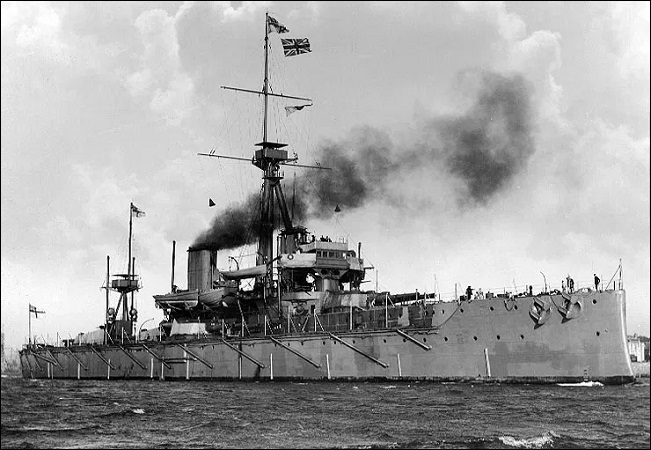
HMS Dreadnought as she appeared
before the war (Imperial War Museum)
There were critics of the new
design, particularly regarding its puny secondary armament,
but Fisher with his typical energy and intemperance trampled
them down. The construction of HMS Dreadnought
commenced in October 1905 and she was commissioned for
service in December 1906—instantly rendering every other
battleship in the world obsolete.
The fallout from Dreadnought’s
appearance was geopolitical as well as tactical and
technical. In Germany the advocates of Weltmacht—
world power—had long been agitating for the creation of a
first-class navy. At the end of the nineteenth century the
possession of overseas colonies and a powerful battle fleet were
held to be prominent among the attributes of a great power.
Germany, it was said, was entitled to its “place in the sun”
alongside Britain, France, Russia and the United States.
Colonies, overseas trade and a navy to defend them—these
would secure for Germany the global power to which she was
entitled.
For a long time, however, the
presence of Otto von Bismarck at the head of the Kaiser’s
government stymied such ambitions. Having engineered the
country’s unification in 1871 the Iron Chancellor declared
Germany to be a “satiated power,” and his foremost concern
was continental diplomacy. United Germany, he said, needed
time to knit together its new imperial institutions.
Bismarck was particularly concerned to prevent another war.
To that end he labored long and assiduously to ensure that
France, defeated and humiliated in the war of 1870-71, could
not acquire a powerful ally for a war of revenge. The most
logical candidate for the position was Russia, which had
grievances of its own. So his diplomatic priority was the
maintenance of good relations with Russia—this despite the
rivalry between the latter and Austria-Hungary over the
Balkans and the Near East. It was a delicate balancing act
and Bismarck thought that Germany’s acquisition of colonies
and a big navy would only disturb that balance. He wanted no
squabbles with Russia, France, Britain or anybody else over
colonial issues. Asked in the mid-1880s about his preferred
map of Africa he replied: “Here is France on one side, here
is Russia on the other side, and here is Germany in the
middle. That is my map of Africa.”
Only grudgingly did Bismarck permit
the acquisition of German colonies in Africa and the
Pacific. He did so as a political concession to the
Weltmacht faction and showed little interest in colonies
thereafter—even proposing at one point to sell German
Southwest Africa to Britain. But with his dismissal by
Kaiser Wilhelm II in 1890 Bismarck’s foot on the imperialist
brake pedal was removed. Public opinion came strongly to
favor an active colonial policy and, in particular, the
construction of a powerful navy.
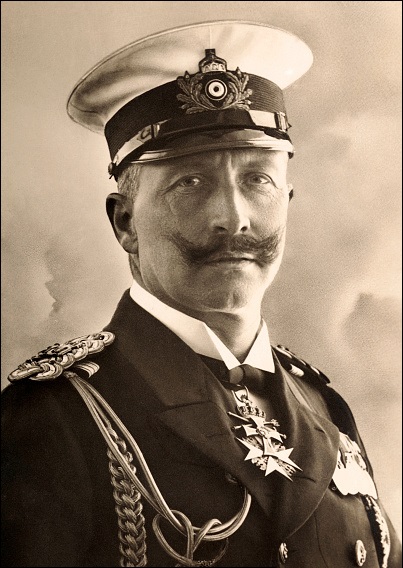
Kaiser Wilhelm II in naval uniform (Wikimedia
Commons)
After 1815 the Kingdom of Prussia
had set about creating a navy of modest size to defend its
Baltic and North Sea coasts, and to show the flag around the
world. The Prussian fleet became the navy of the North
German Confederation in 1867 and of the Imperial German Navy
(Kaiserliche Marine) in
1871. Even so in Bismarck’s time it remained a small force,
decidedly secondary in importance to the Army. But all this
changed after 1888 when a new Kaiser ascended the throne.
Wilhelm II was a naval enthusiast who both admired and
envied Britain’s incomparably powerful Royal Navy. His dream
of a German fleet equal to Britain’s harmonized with public
opinion, though there were many in the political class who
opposed the idea, arguing that more money and manpower for
the Navy meant less money and manpower for the much more
important Army. Therefore the Kaiser proceeded cautiously.
In 1889 he reorganized the naval command structure, creating
an Imperial Naval Office (Reichsmarineamt)
responsible for planning and supervising naval
construction, maintenance and procurement, and advising the
Reichstag (imperial parliament) on naval issues. And
slowly, the fleet began to grow, Germany’s first seagoing
battleships being constructed and commissioned in 1890-94.
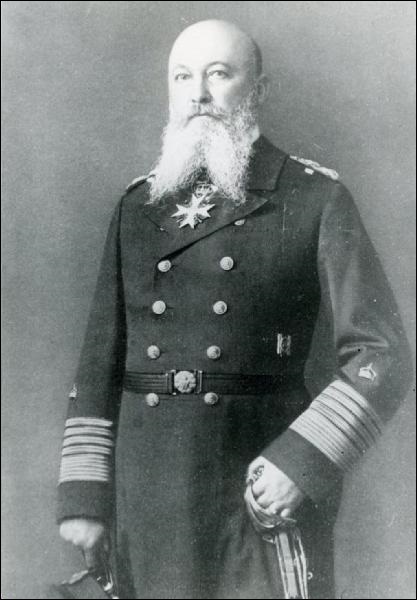
Grand Admiral Alfred von Tirpitz,
architect of the Imperial German Navy (Wikimedia Commons)
The year 1897 was decisive for the
Navy—and, as it proved, for Germany, Europe and the world. A
dispute over the naval budget had led to the resignation of
the State Secretary of the Reichsmarineamt and the
post was offered to Rear-Admiral Alfred von Tirpitz. It was
he more than any other man who transformed the
Kaiserliche Marine
into a world-class navy—posing a threat that Britain, the
world’s preminent naval power, could not ignore.
Shortly after
his appointment Tirpitz submitted his First Naval Bill to
the Reichstag.
It envisioned the construction of a battle fleet of two
squadrons, each with eight
battleships, plus a fleet flagship and two reserve ships.
This program, costing 408 million marks, was to be completed
by 1905. Hitherto the Navy had grown piecemeal; now growth
would proceed on the basis of a seven-year program. The
annual cost—58 million marks—was not much more than the
existing naval budget and though objections were again raised
about funding the Navy at the expense of the Army, the bill
was eventually passed with a comfortable majority. A Second
Naval Bill followed in 1900, this one providing for a fleet
totaling 38 battleships, the program to be completed in
1920.
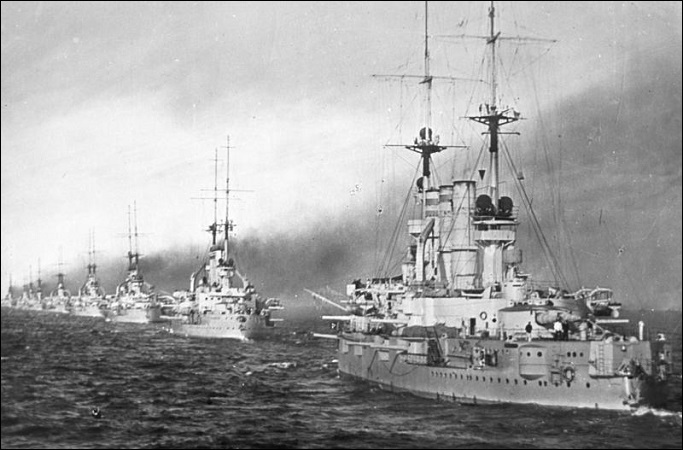
Battleships of Germany's High Seas Fleet,
circa 1910 (Bundesarchiv)
Tirpitz proved
adept at public relations. He established a press bureau in
the Reichsmarineamt
that provided briefings and even pre-written articles for
the convenience of journalists. Speakers were recruited from
business and academic circles to promote the bill,
explaining its necessity for Germany and its benefits for
trade and industry. Tirpitz also sponsored the formation of
the German Naval League (Deutscher Flottenverein)
an interest group favoring a strong navy that did much to
popularize the cause. And he took great pains to cultivate
support in the Reichstag,
patiently and
good-humoredly lobbying its members, answering their
questions and meeting their objections.
Though never
mentioned by name, Britain was the clear target of Tirpitz’s naval program.
Scant notice was taken in
Britain of the First Naval Bill,
but
the passage of the Second
Naval Bill seriously alarmed the Admiralty: The eight “King
Edward VII”-class battleships, ordered in 1902, were
intended as a reply to the German challenge. And the
appearance of HMS Dreadnought
in 1906 gave a tremendous boost to Germany’s burgeoning
naval ambitions. By rendering existing battleships obsolete,
the all-big gun design appeared to give the
Kaiserliche Marine a
real chance to achieve parity with Britain. The ensuing
Anglo-German naval arms race and its diplomatic fallout were
majors factor in the
deterioration of relations between the two countries in the
decade preceding the outbreak
of the Great War.
